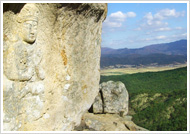|
Gyeongju is the ancient capital of the Silla Dynasty, from where Korea gets much of its unique national culture and history. It is the place to tour
many UNESCO cultural heritage sites. The city also has preserved countless ancient cultural treasures and artifacts. It is growing as a global
city of culture and the arts by being host to a variety of events including the Gyeongju World Culture Expo, the Silla Cultural Festival, and other
festivals about traditional Korean alcohol and ddeok (rice cakes).
|

|
Seokguram Grotto Seokguram Grotto, the greatest masterpiece of the golden age of Silla, is a heritage property in which architecture, mathematical principles, geometry, religion, and art are collectively realized through its design and construction.. website: guide.gyeongju.go.kr/deploy/eng
|
 | |

|
Bulguksa Temple Bulguksa Temple is a prime exemplar depicting Buddhist beliefs through architecture, manifesting an unparalleled architectural beauty difficult to find even in Asia. website: guide.gyeongju.go.kr/deploy/eng
|
 | |

|
Yangdong Village Yangdong Village is a Korean folk village designated as Important Folk Material No. 189, located along the Hyeongsan River 20km northeast of Gyeongju, the city which served as the capital during the millennium-long Silla dynasty. website: guide.gyeongju.go.kr/deploy/eng
|
 | |

|
Cheomseongdae Opposite Daereungwon along a footpath you can see Cheomseongdae in the shape of a traditional liquor jar. It is great to just walk or cycle around town to see the elegance and majesty of Silla. Cheomseongdae is a great starting point for a bicycle tour of Gyeongju. website: guide.gyeongju.go.kr/deploy/eng
|
 | |

|
Mount Namsan Belt As home to numerous Buddhist relics, Mount Namsan is almost like an open-air museum, where the essence of Silla is vibrant and tangible. Relics and ruins include Najeong Well, a central feature in the birth legend of the kingdom website: guide.gyeongju.go.kr/deploy/eng
|
 | |









 >
Tour
> Tourist Attractions
>
Tour
> Tourist Attractions
